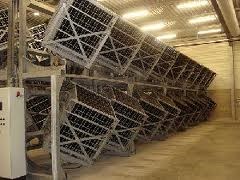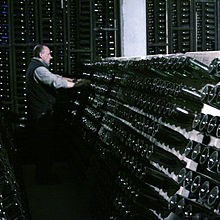Sparkling Wine
what's sparkling wine
Sparkling wine is a wine with presence of carbon dioxide. The carbon dioxide results from natural fermentation. Most still wines have only one fermentation, while in sparkling wines occour 2 fermentations. The first fermentation (alcoholic fermentation) is the one which transforms sugar in alcohol and it’s common to every kind of wine. To add bubbles (carbon dioxide) in wine we need a second fermentation, which can be obtained in 2 different ways:
- Fermentation in bottle, also known as traditional method, or champenoise method. In Italy is called METODO CLASSICO;
- Fermentation in a large tank (usually in stainless steel), called Martinotti Method or Charmat method or Italian Method. In Italy is called METODO MARTINOTTI or METODO CHARMAT
In reality there is another way to put carbon dioxide in wine, which is put it directly in the wine with an injection process, like soda or coca cola. This way is forbidden within EU but some producers outside Europe use this way to produce cheap wines.
To obtain the second fermentation, in both methods, it’s necessary to add a mixture of cultivated and carefully selected yeasts, sugars, and sometimes some wine. This mixture is also known as liqueur de tirage. Let’s see a detailed explanation of the 2 methods:
traditional method
The traditional method is the process used in the ‘Champagne’ region of France to produce Champagne. It is also the method used in Spain to produced ‘Cava’, and to produce a lot of Italian sparkling wines like FRANCIACORTA in Franciacorta region. It used to be known as the méthode Champenoise but the Champagne producers have successfully lobbied the European Union to restrict that term to wines from their region. Thus, wines from elsewhere may not use méthode Champenoise when sold in the EU, and instead traditional method, méthode traditionnelle or the local language equivalent can be used (in italian wines you’ll see METODO CLASSICO).
After primary fermentation and bottling, a second fermentation occurs in the bottle. This second fermentation is induced by adding several grams of yeast (usually each brand has its own secret recipe) and several grams of rock sugar. At this time the wine bottle is capped with a cheap crown cap. During the secondary fermentation the carbon dioxide is trapped in the bottle, keeping it dissolved in the wine. The amount of added sugar will determine the pressure of the bottle. the amount of yeast is regulated by the European Commission to be 0.3 gram per bottle. The liqueur de tirage is then a mixture of sugar, yeast and still wine.
The bottles of wine, temporary capped with that cheap crown wine need to ‘rest’ (aging) for long time (usually from 1 to 3 years but it can be also more than 10 years) on his sediment (lees). After this time the lees must be collected for removal. To do this bottles need to do a process known as riddling. In the past bottles were placed on special racks called pupitres. at a 45° angle with the cork pointed down. Every few days the bottles were shaken and turned and dropped back into the pupitres (increasing the angle). This manual way of riddling sparkling wine is still used, but has otherwise been largely abandoned because of the high costs. Mechanized riddling equipment called gyropalettes are used instead.
.

.

manual riddling (remuage)
.
The lees removal process is called disgorging and was a skilled manual process, where the cork and the lees were removed without losing large quantities of the liquid. Modern disgorgement is automated by freezing a small amount of the liquid in the neck and removing this plug of ice containing the lees.
Immediately after disgorging but before corking with the proper cork, the liquid level is topped up with another mixture called liqueur d'expédition (a French word, it means shipment spirit), because some of the wine gone with lees. At this time, it is common to add a little sugar, a practice which is known as dosage, which means that the liqueur d'expédition consists of a mixture of base wine and sugar, plus some chemical preservatives. Each brand has his own secret recipe for this mixture. It’s possible that someone put old old wine or some spirit in it.
Main european wines produced with traditional method.
In the table there are the most important European wines produced with traditional method. Among them, Franciacorta is the wine which should comply with the most strictly rules. Acutally the most strictly rules in the world for sparkling wines
| wines with second fermentation in bottle | grapes allowed | Maximum yield allowed (hundred kg/hectar) | Minimum time must resting on lees |
| Franciacorta (Italy) | Chardonnay, Pinot Nero, Pinot bianco (max 50%) | 100 | 18 Months |
| Champagne (France) | Chardonnay, Pinot Noir, Pinot Meunier | 144 | 15 Months |
| Trento DOC (Italy) | Chardonnay, Pinot Nero, Pinot Meunier, Pinot Bianco | 150 | 15 Months |
| Oltrepo’ Pavese (Italy) | Chardonnay, Pinot Nero (min. 70%), Pinot Grigio, Pinot Bianco | 100 | 15 Months |
| Cava (Spain) | Macabeo, Xarello, Parellada, and other minor local grapes | 120 | 9 Months |
Martinotti/Charmat Method
The Martinotti method is also called Charmat method or italian Method (in Italy is called METODO CHARMAT or METODO MARTINOTTI). it was invented in Italy and Italy is also the country where is most used.
Instead to make the second fermentation in bottle, the wine undergoes secondary fermentation in stainless steel tanks and is bottled under pressure in a continuous process. Many grape varieties, including Prosecco and Lambrusco, are best suited for fermentation in tanks, because the flavors are more fruity, and makes the wine easier to drink.
denomination according to sweetness
The amount of sugar added in the liqueur d’expédition determine the sweetness of the wine, since the sugar previously present in the wine was consumed in the second fermentation. only wines called zéro dosage (dosaggio zero in Italian) will have no sugar added at all. From the drier level to the sweeter we have:
- Zero dosage (< 1 g/l)
- Brut nature (< 3 g/l)
- Extra brut (< 6 g/l)
- Brut (< 15 g/l)
- Extra dry (from 12 up to 20 g/l)
- Dry (from 18 up to 35 g/l)
- Demi-sec (from 33 to 50 g/l)
- Dolce (doux, sweet) ( > 50 g/l)
Quality of bubbles
Bubbles in sparkling wines should form in any place of the glass and should rise from the bottom to the top in really straight columns. Bubbles should be little and a lot. The way that bubbles move is called Perlage (a word which reminds pearls)




